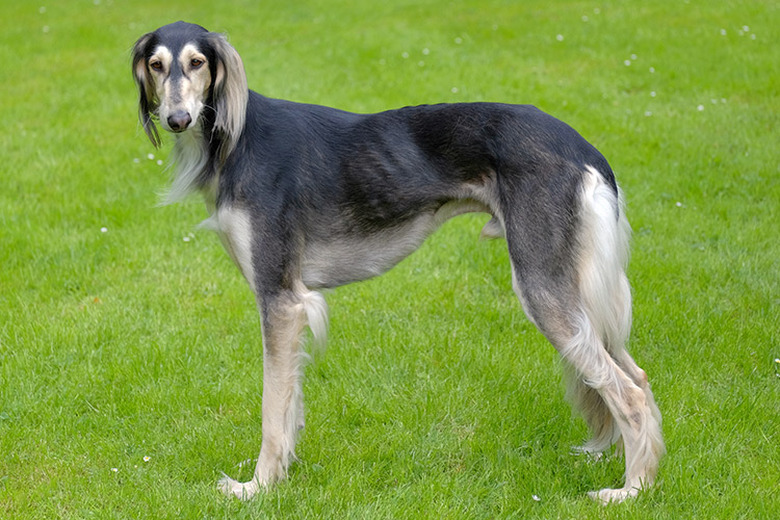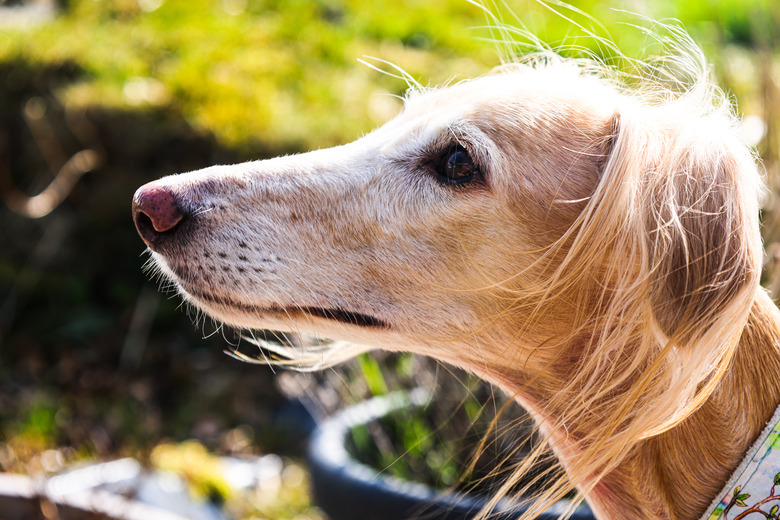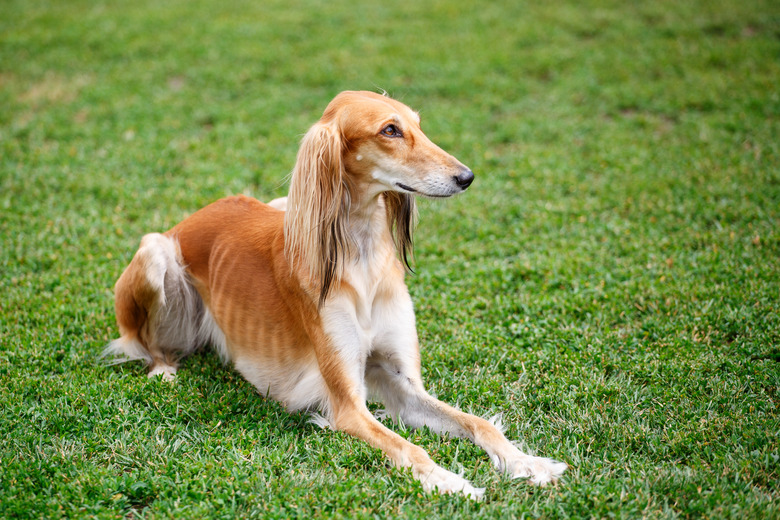Saluki Dog Breed Facts & Information
The saluki is an ancient breed, and they, like some other sighthound breeds, were favorite dogs of Egyptian pharaohs and other kings throughout history. Salukis, like other sighthounds, hunt using sight instead of scent to find and run down prey. The purebred saluki is a beautiful and loving dog, but they are also fast and clever, so make sure you can offer the dog proper care and exercise before bringing a saluki puppy into your home.
History of the saluki
History of the saluki
Until DNA research development, many dog fanciers claimed their dog breed, such as the basenji, saluki, Pharaoh hound, and Ibizan hound, was featured in ancient carvings in the Middle East. DNA tests proved the case for the basenji and saluki as being part of the 14 ancient breeds created by the earliest 4 splits from wolves. Saluki and Afghans were in the fourth split.
Saluki breeding in Europe began in England in 1895. The Saluki or Gazelle Hound Club of England began in 1923 and obtained recognition by the Kennel Club of England. The first saluki in America arrived in Boston in 1861. The American Kennel Club (AKC) accepted the saluki as an official breed in the hound group in 1927 and the Saluki Club of America was formed in the same year.
Characteristics of saluki
Characteristics of saluki
The saluki breed dogs belong to the American Kennel Club's hound group. In the hound group, the breed is part of the sighthound or gazehound division.
Salukis are tall, 23 to 28 inches at the shoulder, but are not heavily built. The average weight is 30 to 65 pounds for dogs with bitches typically smaller and shorter. The nose should be black or liver-colored and eyes dark to hazel. The saluki tail is low. The feather coat variety has silky feathering hairs on the bottom side of the tail, legs, and back of the thighs. The smooth coat variety does not have feathers.
Saluki coat colors are white, black and white, cream, fawn, golden, red, grizzle and tan, tri-color (black, white, and tan). Grizzle is a banding pattern with black or red and white hairs. Salukis have various markings including white collars, feet, splotches, and spots.
Saluki temperament and training
Saluki temperament and training
Breed is not a reliable indicator of personality; however, like other sight hounds, salukis have independent personalities and their hunting instincts result in chasing things that move. They need gentle interactions and are not the best option if you have small children in the home.
The saluki dog is described as cat-like and dogs require patience when training. Early socialization with other dogs and people is important for these dogs as their instincts may drive them to chase small animals.
While consistent training with positive reinforcement can help ensure you have a well-behaved canine citizen, this training is unlikely to override their prey drive and hunting instinct. Be sure to keep your saluki on a leash when you aren't in a safe, confined area with a fence that is at least five feet tall.
Grooming of salukis
Grooming of salukis
Salukis are generally very clean dogs and they don't shed much. If you have a smooth-coated dog, brush them once per week. Feathered salukis need to be brushed twice per week. You can also give an occasional bath with a gentle shampoo formulated for dogs.
These lean dogs don't have much padding and protection from fat or a thick coat, so make sure to offer plenty of cushioned surfaces and a soft bed where they can rest and be prepared for them to nap on your couch. If they spend too much time lying on hard surfaces, they may damage their skin and coat.
Saluki exercise and health
Saluki exercise and health
Salukis are spirited dogs with a high energy level who need plenty of daily exercise to avoid boredom. Daily walks will help burn off excess energy but these dogs need an opportunity to run. It is important that you have access to a fenced area where you can safely let your saluki off-leash to run.
Make sure to also mentally engage your dog. Lure coursing is a favorite sport with many sighthound owners. Other activities to consider include agility, tracking, and even obedience.
Healthy, well-bred salukis have an average lifespan of 13 to 15 years with many living longer. They are generally a healthy breed, but do have some common health issues including heart problems, autoimmune disorders, and, in older dogs, cancer. Saluki and other sighthounds may respond to some drugs and anesthesia differently than other dogs, due to lower body fat and liver metabolism. Owners should discuss the issue with their veterinarians.
Saluki breed puppies
Saluki breed puppies
When looking for a saluki puppy to bring into your home, be sure to purchase from a reputable breeder or adopt from rescue groups. Responsible breeders will test for known health problems.
As with many breeds, most saluki puppy growth occurs during the first year of life. However, both male and female pups will continue to grow and won't reach full size until they are 14 to 16 months of age.
At three months of age, a male saluki weighs 12.9 to 21.3 pounds while a female weighs 12.1 to 19 pounds. At six months the pups have nearly doubled in size with male puppies weighing between 23.6 to 39.6 pounds and females weighing 22.1 to 35.2 pounds. By the time they are a year old, males typically weigh 30.4 to 53.4 pounds and females weigh 28.4 to 47 pounds.
References
- American Kennel Club: Saluki
- Saluki Club of America: Anesthesia and Your Saluki
- American Kennel Club: Lure Coursing: Get Started
- Saluki Club of America: About Salukis
- Saluki Club of America: Is a Saluki Right for You?
- Saluki Club of America: Activities You Can Do With Your Saluki
- Saluki Club of America: Responsible Ownership of a Saluki – It's a Lifetime Commitment
- Belpatt: Weight of Saluki


